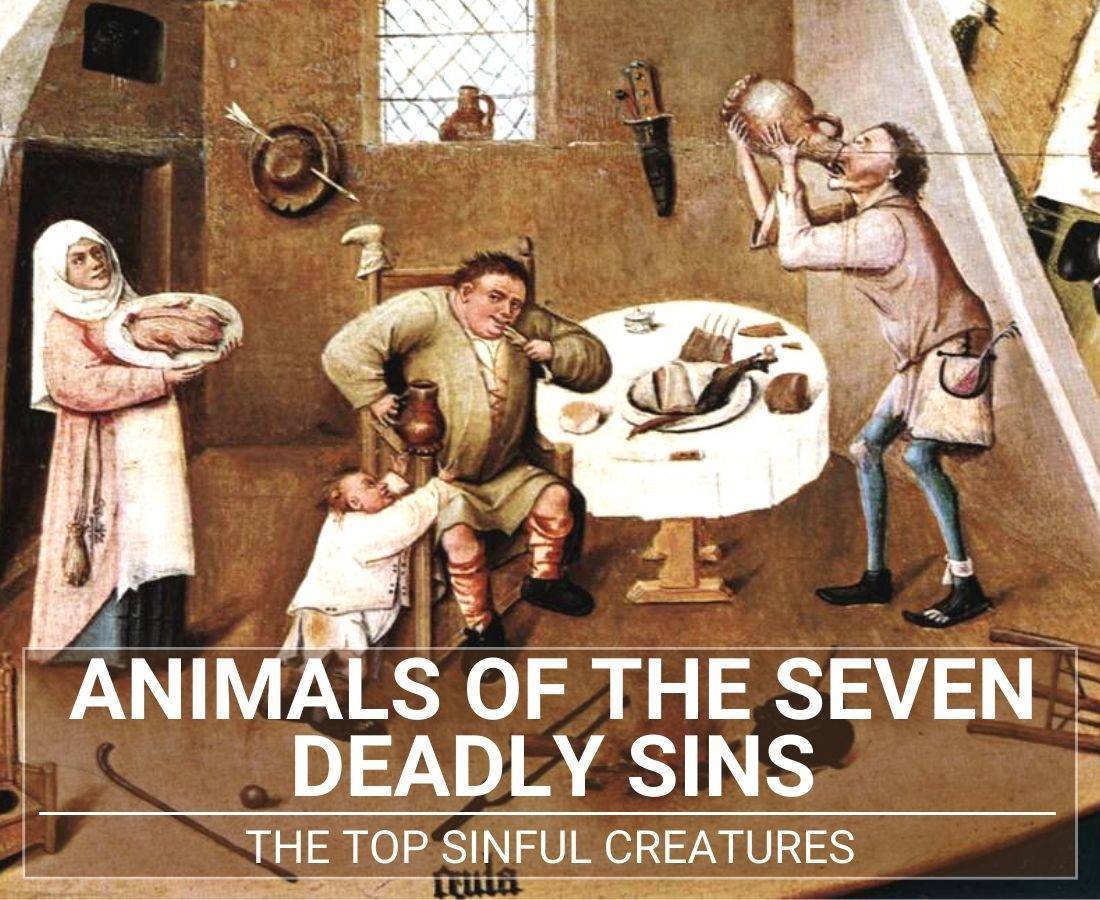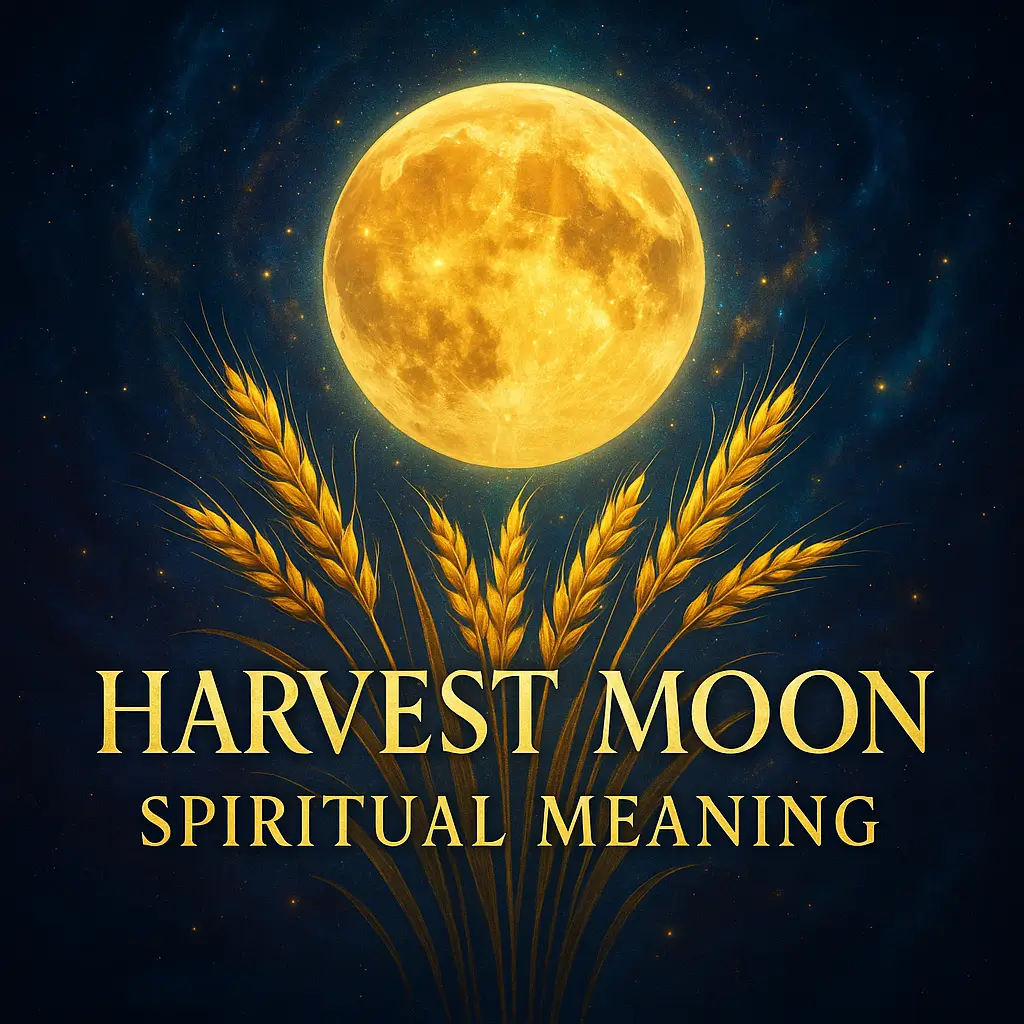Table of Contents
- 1 Key Takeaways
- 2 What Animals Represent the Seven Deadly Sins?
- 2.1 Lust – The Serpent or Goat
- 2.2 Gluttony – The Pig
- 2.3 Greed – The Fox or Toad
- 2.4 Sloth – The Sloth or Bear
- 2.5 Wrath – The Wolf
- 2.6 Envy – The Snake or Dog
- 2.7 Pride – The Peacock or Lion
- 2.8 The Seven Deadly Sins Animals and Their Colors
- 2.9 Redemption Through Virtues – Countering the Animal Sins
- 2.10 Cultural Variations in the Seven Deadly Sins Animals
- 2.11 Modern Interpretations of the Seven Deadly Sins Animals
- 3 FAQ
- 3.1 What animals represent the Seven Deadly Sins in the Bible?
- 3.2 Why is the peacock associated with Pride?
- 3.3 How does the toad represent Greed?
- 3.4 Why is the goat a symbol of Lust?
- 3.5 How does the snake represent Envy?
- 3.6 What makes the pig a symbol of Gluttony?
- 3.7 Why is the wolf associated with Wrath?
- 3.8 How does the sloth animal symbolize Sloth?
- 3.9 What are the seven sins animal symbols and their colors?
- 3.10 What animals represent the seven heavenly virtues?
- 3.11 How do animal symbols for the seven deadly sins vary across cultures?
- 3.12 What animal represents lust in the seven deadly sins?
- 3.13 What animal symbolizes greed?
- 3.14 The Complete Guide to Seven Deadly Sins Animals and Their Symbolism
Key Takeaways
- Each of the seven deadly sins is traditionally represented by specific animals in Christian symbolism – the prideful peacock, lustful serpent, gluttonous pig, greedy fox, slothful bear, wrathful wolf, and envious snake.
- These animal symbols are paired with symbolic colors that enhance their meaning – such as red for wrath, purple for pride, and green for envy – creating a comprehensive visual language for moral instruction.
- Medieval art and literature used these animal archetypes to teach ethical concepts to largely illiterate populations, embedding moral lessons in imagery that could be understood across social classes.
- The seven deadly sins animals have cultural variations worldwide, with Japanese, Chinese, and Islamic traditions offering alternative creatures that reflect different cultural perspectives on human failings.
- Modern interpretations have transformed these symbols from supernatural warnings into psychological archetypes that help us recognize destructive patterns in our own behavior and emotional life.
| Deadly Sin | Symbolic Animal | Meaning & Representation |
|---|---|---|
| Lust | Serpent, Goat | Symbolizes temptation, seduction, and unrestrained desires. The serpent links to deception, while the goat represents carnal instincts. |
| Gluttony | Pig | Represents excess and overindulgence in food, material goods, or experiences, often at the cost of health and moderation. |
| Greed | Fox, Toad | Embodies cunning, hoarding wealth, and material attachment. The fox is deceptive, while the toad symbolizes bloated greed. |
| Sloth | Sloth, Bear | Denotes laziness, neglect of responsibilities, and spiritual dormancy, as seen in the inactivity of these creatures. |
| Wrath | Wolf | Represents uncontrolled anger and destruction. The wolf’s pack mentality also signifies how rage spreads within communities. |
| Envy | Snake, Dog | Reflects jealousy and resentment toward others’ success. The snake whispers deceit, while the dog expresses competitive longing. |
| Pride | Peacock, Lion | Illustrates arrogance and self-importance; the peacock represents vanity, while the lion symbolizes dominance and power. |
What Animals Represent the Seven Deadly Sins?
Have you ever stared into the eyes of a snarling wolf and felt primal fear grip your heart? Or watched a peacock strut with its magnificent plumage and thought about the fine line between pride and vanity? Since ancient times, animals have been our mirrors, reflecting back not just our physical qualities but our moral shortcomings. I remember standing in a medieval cathedral as a child, mesmerized by stone gargoyles with animal features twisted into expressions of human vice. Those creatures, part-beast and part-sinner, have haunted my imagination ever since.
Throughout history, cultures have assigned animal forms to our darkest impulses. These symbolic creatures prowl through our religious texts, artwork, and collective conscience—warning, teaching, and revealing truths about what animals represent the seven deadly sins.
Lust – The Serpent or Goat
The serpent slithers through our cultural consciousness as the ultimate symbol of lust and temptation. In Genesis, it’s the snake that tempts Eve in the Garden of Eden, setting the foundation for its association with seduction and forbidden desire. Its sinuous movements and hypnotic gaze have long represented the way lust can entrance and consume us.
According to The Metropolitan Museum of Art, medieval bestiaries frequently portrayed serpents as creatures of deception and temptation, reinforcing their connection to lustful behavior.
The goat, with its reputation for virility and uninhibited sexual behavior, stands alongside the serpent as lust’s animal embodiment. In ancient Greek mythology, satyrs—half-men, half-goats—were known for their unquenchable sexual appetites. The goat-headed Baphomet became associated with witchcraft and forbidden pleasures in medieval European imagination.
Encountering these creatures in dreams or meditations may signal uncontrolled passions or desires requiring attention and balance.
Gluttony – The Pig

The pig has long borne the weight of representing gluttony in Western symbolism. Its reputation for eating almost anything and its perceived insatiable appetite have made it the perfect symbol for overindulgence and excess.
The biblical prohibition against pork in Leviticus strengthened this connection, with pigs cast as unclean animals. By medieval times, European artwork frequently depicted gluttons with pig-like features—round faces, small eyes, and large bellies.
In Japanese folklore, however, pigs can represent both prosperity and excess—a reminder that gluttony often begins with abundance taken too far. The line between enjoyment and overindulgence blurs easily.
Dreams featuring pigs may reveal areas of life where we consume more than we need, whether food, possessions, or emotional experiences.
Greed – The Fox or Toad
The clever fox has emerged as a powerful symbol of greed across cultures, known for its cunning and willingness to steal. Medieval European tales like those of Reynard the Fox portrayed foxes as crafty thieves and hoarders, willing to manipulate others for material gain.
The toad, too, has strong connections to greed in Christian iconography. Medieval church carvings often depict toads with coins or sitting on money bags. Their bloated bodies were seen as physical manifestations of hoarding wealth, while their connection to the earth symbolized attachment to material possessions.
Both creatures appear in folktales worldwide as warnings against the emptiness of pursuing wealth at all costs. The fox’s cleverness becomes his downfall, while the toad’s possessions weigh him down, preventing spiritual growth.
When these animals appear in spiritual contexts, they may signal an unhealthy attachment to material possessions or a tendency to accumulate without purpose or joy.
Sloth – The Sloth or Bear
The aptly named sloth animal represents spiritual and physical laziness with its extremely slow movements and seemingly perpetual state of rest. Though the animal wasn’t known to ancient Europeans who developed the concept of the seven deadly sins, its later discovery provided a perfect living embodiment of this vice.
The hibernating bear also symbolizes sloth in Northern European traditions. Its winter sleep represents not just physical rest but spiritual dormancy and neglect of duties. In medieval Christian art, bears often appeared as warnings against spiritual slumber and the danger of letting one’s faith grow cold through inaction.
Sloth differs from simple rest in that it represents a willful refusal to use one’s talents or fulfill one’s purpose. Like a slug’s slow spiritual meaning, the slothful person moves through life without direction or purpose.
When these creatures appear in contemplative practice, they may be calling attention to areas where we’ve grown complacent or disengaged from our spiritual journey.
Wrath – The Wolf

The wolf’s ferocious snarl and predatory nature have made it the quintessential symbol of wrath throughout Western tradition. Its pack hunting behavior represents how anger can be contagious, spreading from person to person until it consumes communities.
In Norse mythology, Fenrir the wolf represented uncontrolled rage that would eventually break free and help bring about Ragnarök, the end of the world. This connection between uncontrolled anger and ultimate destruction appears across cultures—wrath doesn’t just harm its target but eventually destroys its bearer.
What animals represent the seven deadly sins often reflects humanity’s fear of our own untamed nature. The wolf reminds us that civilization is a thin veneer easily stripped away by rage.
Envy – The Snake or Dog
The snake’s forked tongue has long symbolized the duplicitous nature of envy. When I first encountered a viper at a wildlife sanctuary, its cold unblinking stare seemed to penetrate my soul—judging, calculating, wanting what it couldn’t have. This ancient creature has represented envy across cultures precisely because of this unsettling quality. In what animals represent the seven deadly sins according to Catholic tradition, the serpent emerges as envy’s perfect embodiment.
In Genesis, the serpent whispers poison into Eve’s ear, planting the seed of comparison: “You will be like God.” This biblical foundation establishes the snake as envy’s avatar, forever linked to the sin that caused humanity’s downfall. The serpent doesn’t simply desire the apple; it desires what the apple represents—status, knowledge, power that belongs to another.
The dog, too, has connections to envy in medieval symbolism. Unlike the serpent’s cold calculation, canine envy manifests as a more emotional, reactive force. Think of a dog growling over its food bowl or barking at passersby from behind a fence—forever wanting what lies beyond its reach. These behaviors mirror the human experience of envy: the painful awareness of what others possess that we lack.
According to this article, artists frequently depicted envious people with dog-like features in manuscripts and church carvings, emphasizing snarling expressions and watchful, jealous eyes. These visual traditions helped illiterate populations understand the spiritual dangers of coveting others’ blessings.
When these animals appear in dreams or meditative states, they often signal hidden jealousies or competitive feelings we’ve yet to acknowledge. The snake might represent subtle, unaddressed envy poisoning your relationships, while the dog could symbolize more openly expressed resentment.
Pride – The Peacock or Lion
The magnificent peacock unfurls its glittering train of feathers, creating a hypnotic display that demands attention. I’ve watched these birds in gardens, seemingly aware of their own splendor, turning slowly to ensure every observer appreciates their magnificence from all angles. Is there any creature more perfectly suited to represent pride among what animals represent the seven deadly sins?
In Christian iconography, the peacock’s ostentatious display symbolizes vanity and unhealthy self-absorption. Its beauty becomes a spiritual trap—a preoccupation with external appearance at the expense of inner virtue. The bird’s legendary concern with its appearance mirrors human vanity in its most recognizable form.
Interestingly, the peacock carries dual symbolism in many traditions. Early Christians associated the bird with immortality and resurrection because of the ancient belief that peacock meat never decayed. This duality reminds us that pride sits at the top of the seven deadly sins not because confidence itself is wrong, but because healthy self-worth can easily transform into arrogance.
The lion, king of beasts, represents a different aspect of pride—the lust for dominance and power. Its regal bearing and territorial nature perfectly embody the domineering aspect of pride. Throughout history, lions have adorned the crests of rulers and conquerers who, like the beasts themselves, claimed territories through strength rather than right.
In biblical symbolism, pride is often called the “father of all sins,” the vice from which all others spring. It’s no coincidence that Satan, once Lucifer the “morning star,” fell through pride, desiring to elevate himself above God. This connects to the symbolism for greed, as both sins involve an unhealthy expansion of the self—pride in status, greed in possessions.
Dreams featuring peacocks or lions often call attention to our own struggles with ego and self-importance. The peacock might represent your need for validation and recognition, while the lion could signal domineering behaviors or an unhealthy desire to control others.
The Seven Deadly Sins Animals and Their Colors

The symbolic connection between what animals represent the seven deadly sins in order extends beyond the creatures themselves to include color associations that deepen their meaning. Medieval artists and theologians developed sophisticated color symbolism to communicate moral concepts to largely illiterate populations.
Lust, embodied by the serpent or goat, pairs with blue—not for its purity but for its depth and darkness. Blue represents the emotional intensity and irrational nature of lustful obsession. The cold-blooded snake wrapped in blue suggests passion divorced from love’s warmth.
Gluttony’s pig wallows in orange, the color of appetite and physical cravings. Like the fruit it shares its name with, orange symbolizes the sweetness of momentary satisfaction that gluttonous behavior pursues at the expense of moderation and health.
The toad or fox of greed bears yellow markings, representing gold and material wealth. Yellow’s association with cowardice also connects to how greed often stems from insecurity and fear of lack, similar to the way certain slugs carry spiritual meaning related to fear-based behaviors.
Sloth bears light blue, representing the empty sky of wasted potential. This pale, washed-out shade symbolizes energy diffused and purpose abandoned. The bear or sloth animal, wrapped in this faded color, represents talents left undeveloped and gifts unused.
Wrath’s wolf blazes in red, the color of blood and fire. This intense hue captures anger’s heat and destructive potential. The red wolf represents not just anger but the violence that often follows when rage remains unchecked.
The envious snake or dog appears in green, traditionally the color of jealousy. Green represents the sickness of spirit that comes from constant comparison and discontent with one’s own blessings.
Pride, embodied by the peacock or lion, drapes itself in royal purple. This rare, expensive dye was once reserved for nobility and royalty, making it the perfect color to represent the sin that places the self above others in importance.
These color associations serve as visual reminders that the seven deadly sins aren’t merely abstract concepts but vivid, emotional experiences that can dominate our lives if left unexamined. By understanding what animals represent the seven deadly sins in the Bible and their color symbolism, we gain insight into the complex nature of human moral struggles.
Redemption Through Virtues – Countering the Animal Sins
What animals represent the seven deadly sins in the Bible doesn’t merely serve as a warning system—these symbols also point toward paths of spiritual redemption. Medieval theologians developed a framework of seven corresponding virtues to counterbalance each deadly sin, each with its own animal symbolism. Like a spiritual ecosystem, these opposing forces create balance in our moral universe.
Humility, represented by the lamb, stands against the prideful peacock and lion. While pride seeks glory and attention, the lamb—central to Christian imagery as the sacrificial “Lamb of God”—embodies meekness and selflessness. In dreams or meditative states, encountering a lamb often signals an opportunity to practice genuine humility in areas where pride may have taken root.
The turtle, carrying its home on its back, symbolizes charity in opposition to the fox’s greed. This unhurried creature takes only what it needs and offers protection to others, demonstrating a life of sufficiency rather than excess. Unlike the acquisitive fox, the turtle shows us how contentment with what we have creates space for generosity toward others.
When examining what animals represent the seven deadly sins in the Bible, we find that the industrious bee counters the slothful bear. The bee’s constant, purposeful activity and community-minded work ethic serves as the antithesis to sloth’s wasteful inaction. The bee reminds us that meaningful labor doesn’t merely produce honey—it creates purpose and serves the greater good.
Cultural Variations in the Seven Deadly Sins Animals
While Western Christian tradition has firmly established what animals represent the seven deadly sins, other cultures offer fascinating alternatives that reveal different moral emphases. In Japanese Buddhist traditions, for instance, the concept of sin differs substantially, focusing more on suffering caused by attachment rather than moral failings.
The Japanese tanuki (raccoon dog) sometimes replaces the fox as a symbol of greed, embodying excessive consumption and attachment to material possessions. In Japanese folklore, the tanuki carries an oversized scrotum symbolizing financial luck, but this “blessing” often becomes a burden—a powerful reminder that wealth without wisdom becomes a spiritual liability.
Chinese tradition offers the monkey as an alternative to the peacock in representing pride. The trickster Monkey King from “Journey to the West” embodies both remarkable abilities and dangerous arrogance, challenging even heaven’s authority before learning humility. This nuanced portrayal shows pride as both a motivation for greatness and a potential downfall.
In Islamic symbolism, which shares Abrahamic roots with Judaism and Christianity, the scorpion sometimes replaces the wolf as wrath’s embodiment, emphasizing the self-destructive nature of anger. The scorpion’s sting, capable of harming others but ultimately leading to its own demise when surrounded by fire, illustrates how unchecked rage consumes the angry person first.
According to National Libaray of Medidcine, these cross-cultural variations remind us that moral frameworks aren’t universal but reflect each culture’s particular concerns and values. The different animals representing similar sins across traditions highlight how ethical systems evolve to address specific social challenges.
Modern Interpretations of the Seven Deadly Sins Animals
In contemporary spiritual practice, these animal symbols have evolved beyond their medieval interpretations. Modern psychological approaches view these archetypes as representations of universal human tendencies rather than supernatural evils. The snake’s envy becomes less about demonic influence and more about our natural but problematic tendency toward comparison and resentment.
Environmental spirituality has transformed how we view animals that represent the seven deadly sins, recognizing that creatures like wolves and bears—once demonized—play vital ecological roles. The wolf, traditionally symbolizing uncontrolled wrath, now represents necessary wildness and the healthy expression of emotional boundaries. This shift mirrors our growing understanding that emotions themselves aren’t sinful—only their destructive manifestations.
Popular culture continues to reinvent these animal symbols. Films like Disney’s “The Lion King” play with the lion’s traditional association with pride, showing both its destructive potential (Scar’s arrogance) and its redemptive possibilities (Simba’s journey to responsible leadership). Such stories suggest that our “sins” often contain the seeds of virtue when properly channeled.
The digital age has introduced entirely new manifestations of the seven deadly sins. Internet “trolls” display the wolf’s wrath without physical violence. Social media platforms encourage peacock-like displays of vanity and constantly trigger snake-like envy through comparison with others. These modern expressions remind us that the animal archetypes remain relevant across changing times and technologies.
By studying what animals represent the seven deadly sins, we gain insight into our own complex natures. These creatures serve as mirrors reflecting parts of ourselves we might prefer to ignore—the envious snake that whispers comparisons, the slothful bear that resists necessary effort, the wrathful wolf unleashed in moments of anger. Yet they also remind us of our capacity to choose differently, to nurture the lamb’s humility, the bee’s diligence, and the turtle’s contentment instead.
Whether encountered in ancient texts, dreamscapes, or modern media, these animal symbols offer a timeless language for understanding the human condition and our ongoing struggle to overcome our least admirable tendencies in pursuit of our highest possibilities.
FAQ
What animals represent the Seven Deadly Sins in the Bible?
While the Bible doesn’t explicitly assign specific animals to the seven deadly sins, Christian tradition and medieval symbolism have created these associations: pride (peacock/lion), greed (fox/toad), lust (serpent/goat), envy (snake/dog), gluttony (pig), wrath (wolf), and sloth (sloth/bear).
Why is the peacock associated with Pride?
The peacock symbolizes pride due to its ostentatious display of feathers and seemingly vain strutting. Its magnificent tail represents excessive self-admiration and vanity. Medieval bestiaries noted how the peacock appears to admire itself, making it a perfect embodiment of prideful behavior.
How does the toad represent Greed?
Toads were believed to hoard precious stones in their heads and consume excessive amounts without satisfaction. Their bloated bodies symbolized the unhealthy accumulation of wealth. Medieval texts portrayed them as creatures that could never have enough, sitting atop money bags in church carvings and manuscripts.
Why is the goat a symbol of Lust?
Goats symbolize lust due to their reputation for hypersexuality and virility. In ancient Greek mythology, satyrs—half-men, half-goats—were known for unquenchable sexual appetites. Biblical imagery also associates goats with sinfulness, while the goat-headed Baphomet became linked with forbidden pleasures in medieval Europe.
How does the snake represent Envy?
The snake represents envy through its connection to the Garden of Eden story, where the serpent’s whispers planted seeds of comparison in Eve’s mind. Its forked tongue symbolizes the duplicitous nature of envy, while its cold, calculating gaze embodies the way envy silently judges and covets what others possess.
What makes the pig a symbol of Gluttony?
Pigs symbolize gluttony because they eat almost anything and in large quantities. Their reputation for insatiable appetite parallels human overconsumption. Biblical prohibitions against pork strengthened this negative association, while medieval artwork frequently depicted gluttons with pig-like features—round faces, small eyes, and large bellies.
Why is the wolf associated with Wrath?
Wolves represent wrath through their ferocious snarl and predatory nature. Their pack hunting behavior symbolizes how anger spreads contagiously through communities. In Norse mythology, Fenrir the wolf embodied uncontrolled rage that would eventually break free and help bring about Ragnarök, illustrating wrath’s ultimately self-destructive nature.
How does the sloth animal symbolize Sloth?
The sloth animal represents spiritual and physical laziness through its extremely slow movements and seemingly perpetual state of rest. Though discovered after the seven deadly sins concept developed, its later discovery provided a perfect living embodiment of this vice—the willful refusal to use one’s talents or fulfill one’s purpose.
What are the seven sins animal symbols and their colors?
Medieval tradition paired each animal with symbolic colors: lust’s serpent with blue (irrational passion), gluttony’s pig with orange (appetite), greed’s fox with yellow (gold), sloth’s bear with light blue (wasted potential), wrath’s wolf with red (blood/fire), envy’s snake with green (jealousy), and pride’s peacock with royal purple (self-importance).
What animals represent the seven heavenly virtues?
The seven virtues have their own animal symbols to counter the deadly sins: humility (lamb) against pride, charity (turtle) against greed, chastity (dove) against lust, kindness (rabbit) against envy, temperance (elephant) against gluttony, patience (ox) against wrath, and diligence (bee) against sloth.
How do animal symbols for the seven deadly sins vary across cultures?
Cultural variations abound: Japanese traditions sometimes use the tanuki (raccoon dog) instead of the fox for greed, Chinese symbolism offers the monkey as an alternative to the peacock for pride, and Islamic tradition may use the scorpion rather than the wolf to represent wrath’s self-destructive nature.
What animal represents lust in the seven deadly sins?
The serpent and goat traditionally represent lust. The serpent’s sinuous movements symbolize seduction and forbidden desire, referencing the biblical temptation in Eden. The goat, with its reputation for virility and uninhibited sexual behavior, connects to ancient Greek satyrs and medieval European associations with witchcraft and forbidden pleasures.
What animal symbolizes greed?
The fox and toad symbolize greed across cultures. The clever fox, portrayed in medieval tales like those of Reynard the Fox, represents cunning theft and hoarding. The bloated toad, often depicted sitting on money bags in church carvings, symbolizes the physical manifestation of hoarding wealth and unhealthy attachment to material possessions.
The Complete Guide to Seven Deadly Sins Animals and Their Symbolism
Throughout history, the seven deadly sins animals have served as powerful visual reminders of humanity’s moral failings. The tradition of associating specific creatures with each sin originated in early medieval Christian teachings, where animals that represent the seven deadly sins in the Bible became central to religious instruction. When exploring what animal represents the seven deadly sins, we discover a rich tapestry of symbolism that varies across cultures yet maintains consistent psychological insights. The 7 deadly sins animals—from the prideful peacock to the wrathful wolf—appear in artwork, literature, and spiritual teachings worldwide, offering a universal language for understanding human vices.
Animals associated with gluttony, particularly the pig, remind us of consumption without restraint, while animals that represent greed, like the fox and toad, warn against material obsession. The animal representing lust—typically the serpent or goat—speaks to uncontrolled desire, and the animal representing wrath—the fearsome wolf—embodies destructive anger. The animal that represents sloth, whether bear or actual sloth, cautions against wasted potential, while the animal that symbolizes pride—the ostentatious peacock—warns of excessive self-importance. The animal that represents envy—the coldly calculating snake—shows the poisonous nature of jealousy. By understanding the 7 deadly sins animal representations, we gain deeper insights into our own moral challenges. The 7 deadly sins animal symbols continue to resonate in modern psychology, where therapists might use these archetypes to help patients recognize destructive patterns in their lives, proving that these ancient symbols remain relevant in contemporary spiritual and therapeutic practices.




Wow!!! You can’t imagine how useful I found this post!!! Thank you!!!
richard this was a fire post learned alot someone give this dude a plaque
Hey, thanks for your awesome feedback! I’m thrilled you enjoyed the post. If you have any topics you’re curious about, let me know. Your support means a lot – keep diving into the world of symbolism with me! ????